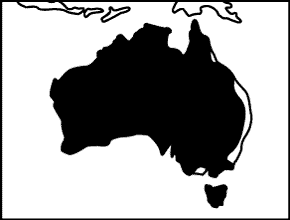

The emu is the second largest living bird, after the ostrich. It stands 150 to 180 cm tall. The female weighs about 40 kg, and the male about 35 kg. The feathers on the body resemble hair, and the neck and head are often bald. The beak is broad and soft, suitable for grazing. The wings serve as radiators in hot weather, being held out from the sides.
Only one species of emu exists today. Three other island species living along the southern coast of Australia were eradicated shortly after the arrival of Europeans. The surviving species occurs throughout Australia.
Diet consists of vegetation, seeds, and insects. Pebbles are taken up to aid digestion.
Nests are built of twigs and leaves, and situated to allow the bird a clear view. The female lays from nine to twelve eggs, which the male incubates. Two or three days after hatching, the chicks are ready to leave the nest, and often walk ahead of their father instead of following him.
